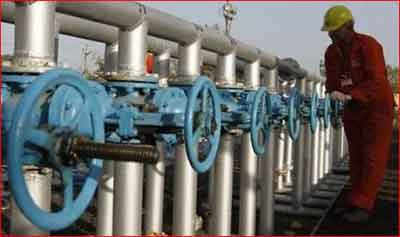Date: 10/04/2022
Relevance: GS-3: Infrastructure: Energy, Ports, Roads, Airports, Railways etc.
Relevance: GS-2: Government policies and interventions for development in various sectors and issues arising out of their design and implementation.
Key Phrases: “market-oriented pricing” and “administered” pricing, a gas-based economy, LNG demand /supply, clean energy.
Why in News?
- The Ministry of Petroleum had constituted a committee, headed by energy expert Kirit Parikh, to review the domestic natural gas pricing regime.
Concerns over the committee:
- Reconciliation of the task assigned:
- The committee’s terms of reference suggested it was tasked to square the circle between “market-oriented pricing” and “administered” pricing.
- The committee was directed to develop “market-oriented, transparent and reliable pricing regimes” to facilitate “India’s long-term vision for ensuring a gas-based economy” and, examine the issues related to ensuring “a fair price to the end consumer”.
- Several committees in the past:
- Their combined impact has been to create a landscape dotted with a potpourri of gas pricing regimes.
- This is because the recommendations made by one committee have not replaced those made earlier.
- This latest initiative might add a further layer to this already “notoriously complex” stack.
- Composition of the committee:
- The composition of the committee suggests the government has plans to further tighten controls over natural gas pricing.
- Four of the six members are from the public sector. There is a concern that they will not recommend steps that diminish their role.
- This will have a negative impact of the move on the government’s objective to move forward “towards a gas-based economy”.
Viability of gas reserves:
- IHS CERA has estimated India has undiscovered gas resources of approximately 64 trillion cubic feet (TCF).
- The bulk of this is, however, in harsh topography and complex geology and these reserves are difficult to locate.
- Furthermore, even if located, they are difficult to bring to market on economically viable terms.
- This is because the cost of creating the development and production infrastructure is massive.
- BP and its coventurers have, for instance, spent about 5 billion dollars over the period 2011d and 2019 to produce 3 TCF of gas.
- They expect to spend a further 6 billion dollars to produce an additional 3 TCF.
- The reality is India is a high-risk exploration play and there are inherent geologic, technical, and economic obstacles to achieving commercial success.
Pricing:
- Constraint of administered pricing:
- There is a constraint of administered pricing and it would most definitely kill incremental investor interest.
- Government should also note that petroleum companies have reduced their exploration budgets under pressure to shift away from fossil fuels.
- Combined impact of various committees:
- As regards gas pricing, the landscape is currently dotted by a mix of cost plus, replacement value, and formulaic pricing principles. This is because the recommendations of various committees have been additive.
- Initially, when licenses were issued to PSUs on a nomination basis, the price of gas produced by them was set by the Ministry of Petroleum on a cost-plus basis.
- There was no controversy as exploration was the exclusive preserve of government companies.
- In later years, following the involvement of the private sector, prices were linked to replacement substitute fuels.
- Then, in 2014, a committee recommended that domestic prices be tied to the weighted average price of gas in the UK, US, Canada, and Russia — a curious decision as the latter were exporters of gas whereas India was a gas deficit and an importer.
- In 2016, another committee suggested that the gas produced from deep waters under conditions of high temperature and high temperature be capped to the minimum of the weighted average import price of fuel oil, naphtha, and coal (as a collective) and the six-month lagged, landed price of LNG. This too was curious as it did not take into account the seasonality of LNG demand /supply and LNG prices.
- There have been several tweaks thereafter but none have allowed for the full mirroring of market dynamics.
- There is today a disparity between the domestic price of $ 12.47 /mmbtu (for gas from deep waters) and the price prevailing in the Asia Pacific region of $ 36/mmbtu. This discount is a disincentive to potential international investors.
- Ukraine crisis:
- In the wake of the Ukraine crisis, the international energy market has undergone a profound transformation.
- It has fragmented and governments are responding to the rise in gas prices by walking back on the market.
- They are intervening through price controls, subsidies, and the allocation of public funds for the creation of gas infrastructure.
What course should India adopt?
- It should clear up the existing complexity and, other than for producers of gas from nomination blocks, permit all producers of gas to determine prices through arms-length, direct, and transparent negotiations with different consumer segments.
- The concern that this will lead to price gouging or unaffordable prices is exaggerated as producers can only sell in the Indian market.
- There are no liquefaction facilities for the export of LNG in India. Subsidies may have to be provided but if so, they should be given directly by the government, through the exchequer. The gas producers must not be asked to bear that brunt.
Conclusion:
- India has made impressive progress towards clean energy. It has, however, a long way to go before it can fully wean itself off fossil fuels. During this transitional phase, gas producers should be granted unfettered marketing and pricing freedom. Only then might gas provide a solid bridge.
Source: Indian Express
Mains Question:
Q. "India’s ambition towards building a gas-based economy will need more elaborate policy reforms." Examine the challenges that India must overcome to transition to a gas-based economy and suggest some policy measures to overcome the challenges.






















